We choose a tape for the grinder
In the market of grinding equipment, you can see a large number of electric and pneumatic tools, which differ in both the principle of operation and purpose. But no matter what type of tool, without consumables (tooling), it can not work. The success of the work depends on the right choice of this important detail.
Content
Types of nozzles for different grinders
Grinding machines (BL) are used for processing virtually any material: wood, plastic, metal, stone, concrete, paint and varnish coatings, glass, etc. Accordingly, the nozzles for the grinder can also have a different shape, be made of special materials and intended to perform specific work.For grinders of various types, there are the following types of nozzles.
Straight grinder
For direct grinding machines, which are mainly used for stripping and grinding parts in hard-to-reach places, they are used emery circles.

If it is necessary to perform more precise work, a set of various cones is provided for the direct type grinder.

Vibrating
This type of CMM has a flat rectangular sole, on which are fixed sanding sheets using special clamps. Emery sandpaper for vibration-type grinders has holes designed to remove fine dust. They coincide with recesses located on the base of the unit.

Deltoid
In a deltoid grinder, the sole may look like a working iron sheet or have a triangular shape. Accordingly, the shape of the equipment will have a similar appearance.
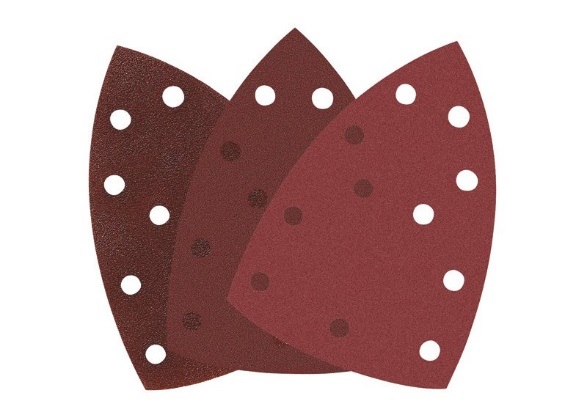
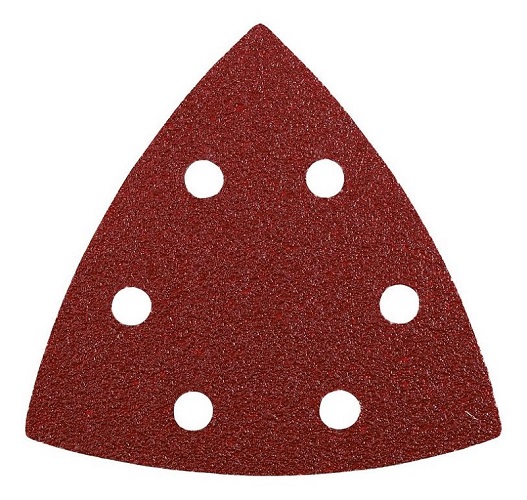
Brush
It is not difficult to guess that the main tool for this type of CMM - nylon brushwhich is used for brushing wood.

Also on the brush units can install lamella grinding nozzles roller type.
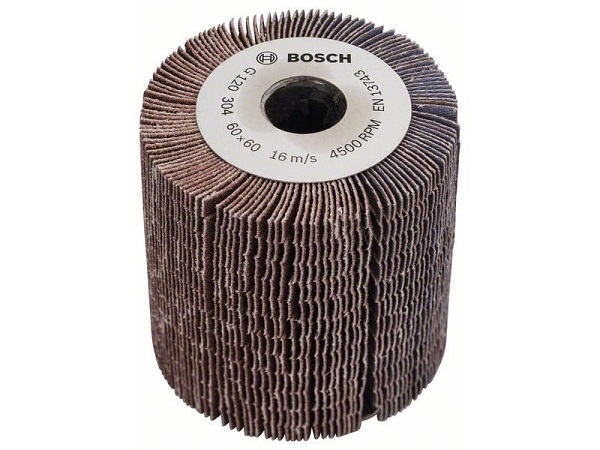
Eccentric (orbital)
“Orbitalka” is a unit that performs the highest quality surface treatment. On eccentric CMM is installed round skincorresponding to the shape of the sole of the unit.
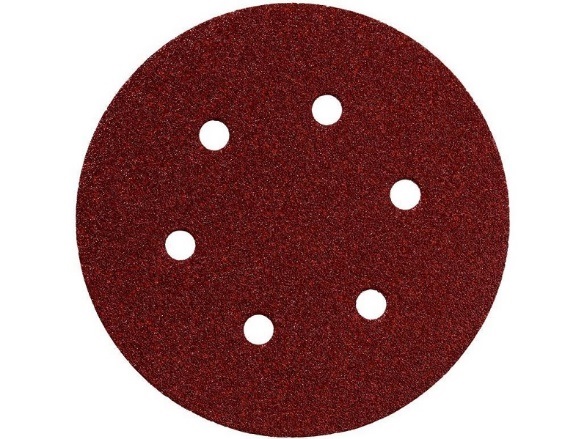
Polishing
This unit is used for polishing paint coatings, for example, car body after painting.
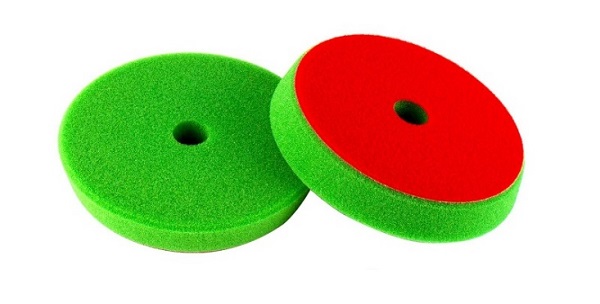
For finishing coatings use felt nozzles on sanding machines, as well as foam rubber.
Tape
On tape CMM install sandpaper, glued in the form of a ring. On both sides of the sole of the unit there are 2 shafts, one of which is a tension roller. On the given rollers and the equipment which is an endless abrasive tape is put on.
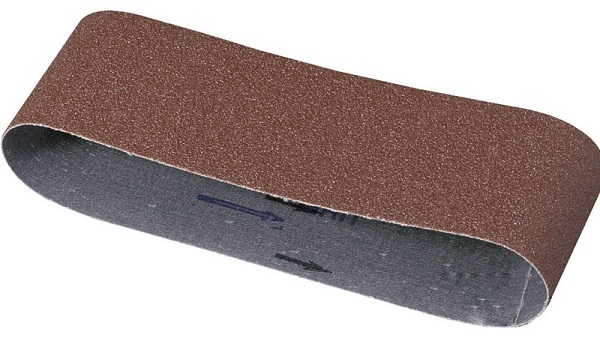
Sandpaper classification
Despite all the variety of devices for grinding and polishing, the most popular tool is a belt grinder, which uses an endless abrasive belt. But for high-quality processing of materials it is not enough to have this unit and a pair of sanding belts. For each type of work it is necessary to choose the right equipment, not only in grain, but also in size, type of base.
The foundation
Various materials can be used as the basis for sanding belts.
- Tapes with printed on paper base abrasives are the most common, besides the price of them is the lowest. Their basis, that is, the paper web, is impregnated with resins and polymers, which significantly increase its strength and resistance to abrasion, tearing, bending. Impregnation will apply a shlifenta moisture resistance. But it is worth knowing that such tapes are not used for intensive work, since paper is still a fragile material. Usually paper based tapes have fine grain.
- Abrasive belts made fabric based, have good resistance to wear and work longer than equipment, made on paper. The fabric cloth not only holds the abrasive crumb well, but also has good elasticity and moisture resistance. Cloths with a fabric base can be used for intensive grinding work, both on soft materials and more dense ones, for example, for processing hard wood species. Also from this material do equipment on a flypaper for other types of BL.
- Tissue paper canvas combine the best qualities of both materials: elasticity, resistance to bending and abrasion, moisture resistance. Usually, coarse emery cloths are made on a combined basis.
Any kinds of emery cloths can be purchased in bulk, that is in rolls. This allows you to significantly save money, especially in production, since it is not difficult to make a tool of the desired shape and size with your own hands for most grinders.
Marking
On any emery paper marked marking indicating the concentration of abrasive and its fraction. If you rely on domestic GOST 3647-80, then it indicates how many abrasive grains are per square unit. These definitions are obsolete today, since the new international standards (ISO). Accordingly, they are marked on the back of the product. Below is a table that lists all types of grain, as for GOST 3647-80, and for ISO.
The main difference between the old and new standards is that according to GOST, the density and size of abrasive grains are reduced, respectively, and in ISO the number in the product name increases in proportion to the decrease in the number of grains per square square.
Simply put, the larger the figure behind the letter “P”, which stands for grit, the smaller will be the fraction of abrasive on the emery cloth. For example, everyone knows sandpaper called “null”Will be labeled P400. And products with the designations P600 ... P2500 have such a small fraction that it is almost imperceptible to the touch.
And vice versa, the marking according to the old GOST is interpreted as follows: the number before the letter indicates that an abrasive crumb is applied to the surface of the grinding cloth, corresponding to sieve size. For example, marking 10-H means that the mesh size of the sieve through which the abrasive was sieved is 100 microns. Therefore, the smaller the figure in the marking according to GOST, the smaller fraction of the crumbs applied to the canvas.
Abrasive material
When choosing a belt for a grinding machine, one should take into account such a parameter as an abrasive material, which is no less important than the base of the product. Abrasive chips for emery cloths are made from several materials.
- Ceramics. This material produces coarse sandpaper used for roughing wood,and also for quick grinding of layers of material, for example, when leveling planes in height.
- Carborundum (silicon carbide). Most often used for finishing plastics, cast iron, steel, aluminum, bronze, granite, marble, glass, hard wood, that is, materials with hard surfaces.
- Electrocorundum (aluminum oxide). It is the most widely used abrasive material. It has an increased service life due to the fact that its “soft” crystals in the process of grinding, breaking off, form smaller, but no less sharp crystals. Grinding cloths from electrocorundum are used for processing wood, hardened and unhardened steels, ductile iron.
- Garnet. A crumb of this mineral is both soft and tough. After processing any material with a garnet-coated canvas, an even and smooth surface is formed. Therefore, sanding tape with garnet chips are used for finishing the products of soft wood.
- Synthetic diamond. Diamond sandpaper is the most durable and at the same time the most expensive.It has a very high wear resistance and is used in industry for grinding and polishing metal products.
How to glue sandpaper
Many owners of belt grinders, especially with large volumes of work, face the problem of the lack of abrasive belts at the right time. In stores selling equipment for CMM, you can see that the sanding belt of different grain sizes is sold in rolls. But not everyone knows for what purpose it is sold in such quantity. In fact, the abrasive can be bought on the footage and use it for vibrating CMM, cutting out small sanding sheets from the web and punching holes in them to remove dust. Also, no one forbids and glue sandpaper for belt sanders with their own hands and at home. The algorithm for gluing abrasive tape is as follows.
Cut a piece of emery paper of the desired length. For example, you can take a sanding belt already used by cutting it. Measure the length of the tape, add 10 mm to it for overlap and apply the resulting size on the back of the sandpaper.
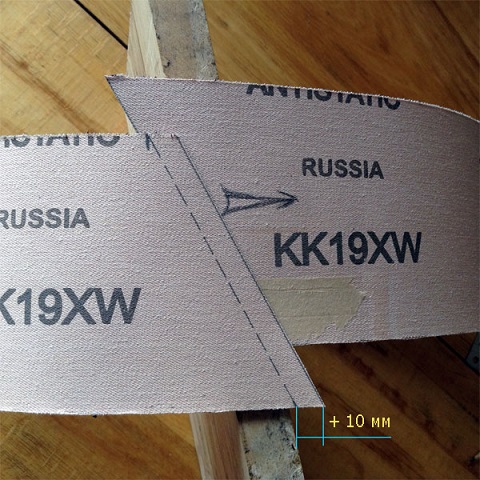
The tape must be cut at an angle of 45-50 degrees, taking into account the direction of grinding. Usually on all grinding cloths there is an arrow indicating in which direction the tooling should work. When gluing you need to arrange the ends of the tape as shown in the figure above.
Next, you should prepare the glue and a small wooden bar. In this case, in order to glue the tape together, it is used PVA Kleiberit 300 gluewhich is delivered both in big packaging, and in small.
The peculiarity of this glue is that it can be used for hot bonding of parts.
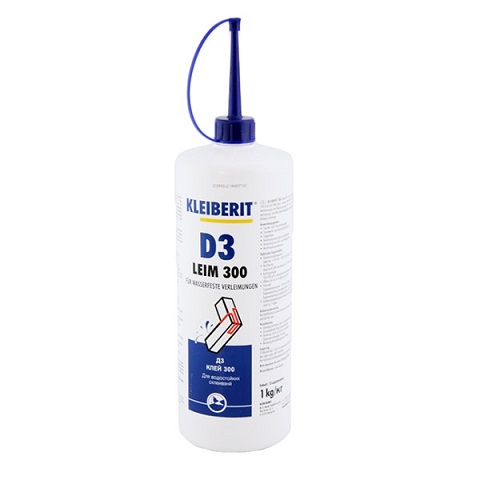
On one side of the tape, at a distance of 10 mm from the edge, draw a line using a ruler and a sharp object. The mark is made directly on the abrasive.

Bend the sandpaper in the place of a notch and clean it with a knife.

Apply glue to the prepared strip and using preheated iron glue this section of the tape to a wooden bar (30 seconds will be enough).


After the end of the warming up, carefully tear off the glued area of emery from the wooden bar. As a result, you get the end of the tape, cleared of abrasive chips.
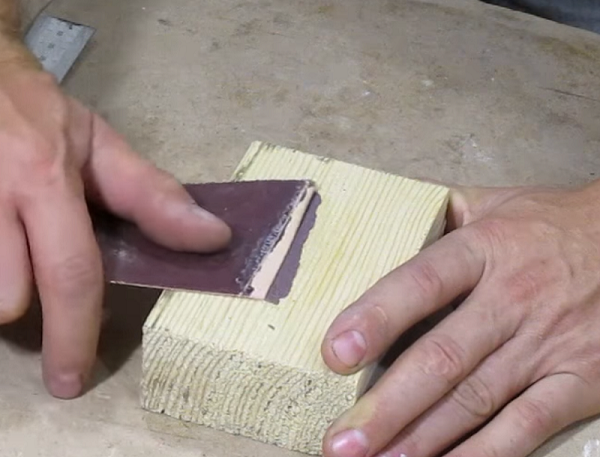
Abrasive residues can be removed with a knife, aligning the strip on the previously marked mark.

Next, apply glue to the stripped portion of the tape.
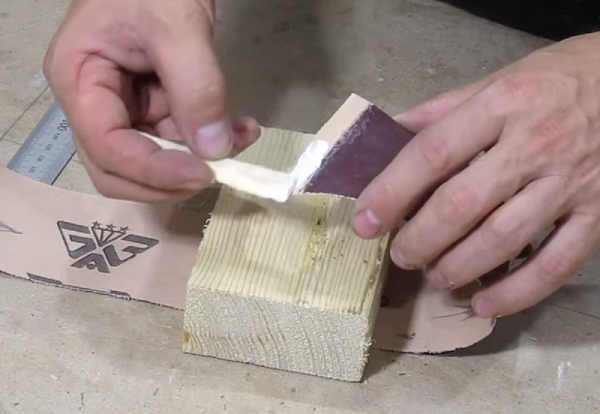
Smoothly connect the ends of the emery cloth and warm the glueing area with an iron on both sides.
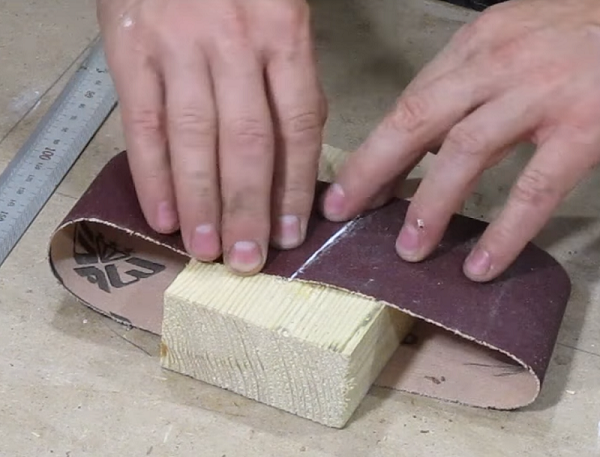


After the bonding process is finished, allow the tape to cool slightly, after which it will be ready for use. As a result, you get an inexpensive sanding belt, which does not differ in quality from the factory analogues.
The cost of self-made tape for CMM, can be easily calculated. Q1 m of sandpaper, costs, on average, 250 rubles, and grabs it for the manufacture of about 10 sanding belts (depending on the model of the unit). This means that 25 rubles are spent on one tape. Glue can be bought at a price of 360 rubles per 1 kg. It is enough for gluing about 300 tapes, that is, 1.2 rubles are spent for one tape. It turns out that a homemade tape costs 26 rubles 20 kopecks, which is much cheaper than a ready-made tooling, the price of which starts from 100 rubles per piece.

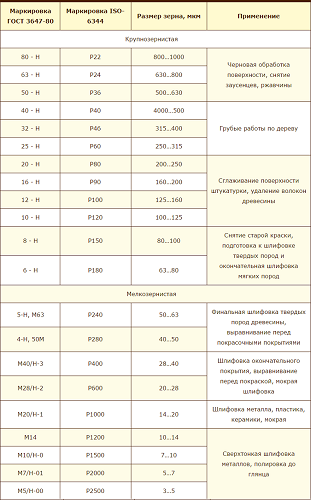
/rating_off.png)











